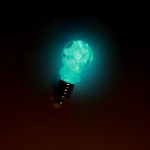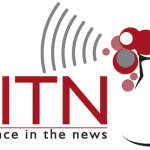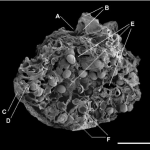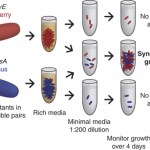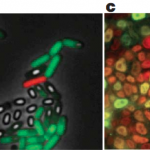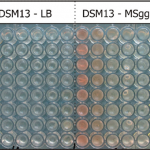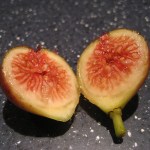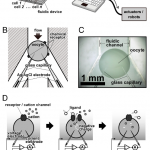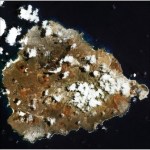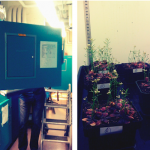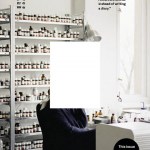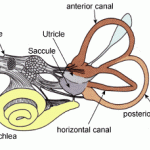
There's a neat article in the Guardian today about designing new foods with genetic engineering and biotechnology.
Food, science, and design are intertwined from how we grow our food to how we eat it, from microwavable dinners to three-star molecular gastronomy at El Bulli. Designers like Oron Catts and James King who explore the possible future of synthetic biology and biotechnology present new ways of thinking about producing and shaping new foods like in vitro meat.
Although the work of designers such as Catts and King is speculative, it raises interesting questions about the future role…
This year's Cambridge iGEM team has made a tiny, wireless lightbulb filled with bioluminescent bacteria! There are two main ways of engineering luminescence in E. coli (I assume these are E. coli, correct me if I'm wrong!). One is to express the luciferase gene from fireflies, which adds ATP and oxygen to the chemical luciferin, producing oxyluciferin and yellow, green, or red light.
Since the lightbulb is blue, this bacteria is probably expressing the Lux operon from Vibrio fischeri, which use their bioluminescence in an awesome underwater symbiosis. From the Cambridge iGEM wiki:
Some…
The new season of Science in the News starts next week with a great schedule of science lectures by Harvard grad students free and open to the public. If you're in the Boston area, definitely check it out!
Here's the schedule:
September 22: Evidence-based Medicine: A Case Study of Vaccines and Autism
September 29: Bots That Mimic Bugs: Flying, Crawling, and Squishy Robots
October 6: You Are What Your Mother Ate: The New Science of Epigenetics
October 13: Beyond Agribusiness: New and Old Ways to Grow Food
October 20: The Laser Turns 50: A Brief History and New Frontiers
October 27: Forget-Me-…
Thanks to some informative comments on my post about figs and wikipedia my knowledge of botany is slowly improving and my admiration of figs steadily increasing. Many species of figs are pollinated by symbiotic wasps, but there are other fig varieties that develop edible, seedless figs through a process called parthenocarpy. A dominant mutation in the plant allows unfertilized flowers to stay on the tree and develop into yummy figs. While these seedless fruits are delicious, the plants that produce them are sterile, able to reproduce only through human intervention.
Fig trees are…
My good friend and labmate just published an awesome paper: "Emergent cooperation in microbial metabolism." His experiment started with 46 strains of E. coli that had mutations in their metabolic pathways that prevented them from being able to grow without supplementing the media with extra metabolites. Alone they died, but grown together in the same tube, many pairs of mutants were able to feed each other the missing metabolite. Metabolic cooperation was the key to survival.
Measuring and understanding metabolic cooperation can be used to build stronger, more predictive models of…
Noise obscures meaningful information. Noise is what ruins your carefully designed synthetic biology gene circuit. But noise is part of life and life, it turns out, needs noise. There's a terrific review article in this week's Nature discussing recent theoretical and experimental work on biological noise showing functional roles for molecular, genetic, and evolutionary noise.
From the abstract:
The genetic circuits that regulate cellular functions are subject to stochastic fluctuations, or 'noise', in the levels of their components. Noise, far from just a nuisance, has begun to be…
Cells are constantly jibber jabbering, sending messages to each other to coordinate behavior, both within a population of single-celled organisms or between cells of an individual multicellular organism. Most of these signals are chemicals that float around in the liquid that surrounds the cells but there recently has been an increased appreciation for cells' sense of "smell"--how cells respond to chemicals that are present as gasses.
A brand new paper outlines the discovery of "olfaction" in a species of bacteria, Bacillus licheniformis. Trying to save space on a 96 well dish by putting…
A delightful lunch conversation about fruits introduced me to what may be my new favorite symbiotic relationship! Figs are not actually fruits but a mass of inverted flowers and seeds that are pollinated by a species of tiny symbiotic wasps. The male fig flower is the only place where the female wasp can lay her eggs, at the bottom of a narrow opening in the fruit that she shimmies her way through. The baby wasps mature inside the fig into males that have sharp teeth but no wings and females ready to fly. They mate, the males chew through the special fig pollen holders and drop them down to…
A lot of synthetic biology is about getting biology to be more like electrical engineering, designing genetic "logic gates" to create a living circuit board. Beyond analogies, however, cells have many fascinating electrical properties--proteins that transfer electrons like wires, membranes that separate ions and create an electrical charge that drives the metabolism of the cell, channels through these membranes that open and close to activate an electro-biological response. Electrons are electrons whether they are in proteins or copper wires, and many scientists have designed ways to connect…
Life transforms environments, creating ecosystems where there was once only rocks. The evolution of photosynthetic bacteria billions of years ago created the atmosphere we have today, paving the way for the evolution of larger, oxygen-breathing organisms. We humans obviously transform our environment in countless ways, but can we also engineer barren environments to be hospitable to life? Can we create new living, self-sustaining ecosystems in hostile places? Can we turn lifeless planets into second Earths through the clever introduction of life forms?
Terraforming is the (currently…
Check out this awesome video of a computer-controlled swarm of magnetic bacteria building a pyramid out of tiny bricks!!!
From IEEE Spectrum, via It Takes 30, the always fascinating blog from Harvard Systems Biology, the department my lab is in!
Sometimes among all of the tedious protocols and mundane inconclusive data, I forget that I'm doing something amazing and incredibly powerful. Almost all my experiments require altering a living organism to do my bidding--to hold onto and replicate a piece of DNA that I'm interested in or to produce an enzyme that I want a lot of. Thanks to iGEM this summer I've gotten to learn some new soon-to-be-tedious protocols that seem absolutely thrilling now, and the experience is reminding me of how awesome (in the real sense of the word) genetic engineering is.
The team is working with the model…
There's a terrific new article in New Scientist about some of the ways scientists are working on turning pee into energy. There's a lot of pee in the world all going to waste, often at huge cost to the environment in terms of energy used to collect and purify waste water. Methods that can produce even small amounts of power from urine could be useful to help power office buildings or farms where there are a lot of people or animals all peeing in the same place, and smaller fuel cells could even also be used to power portable electronics, with no need to carry any fuel or batteries, just a…
A recent survey of 3,000 people worldwide found what many have known all along--that Legos are the best toy ever made. For synthetic biologists, this doesn't come as much of a surprise--Legos are at the heart of the concepts underlying the basics of synthetic biology.
Legos are a favorite analogy for BioBricks, the DNA parts that are made to easily "snap" together using a shared genetic engineering strategy. The iGEM competition is structured around BioBricks, with undergraduate teams combining old and creating new BioBricks for the Registry of Standard Biological Parts, competing for the…
It turns out that my wonderful iGEM students, besides being brilliant scientists, are also excellent, hilarious actors. Please enjoy their Jersey Shore inspired video about molecular cloning:
My Synthetic Aesthetics partner, Sissel Tolaas, is featured in the terrific current issue of the German interview magazine mono.kultur. Her work focuses on smell, exploring the unique smellscapes of different cities, creating provocative scents to show in art galleries, branded "logo" scents for Adidas, "Swedish" scents for Ikea, and therapeutic memory-triggering scents, part of the healing process for patients dealing with traumatic experiences. Until we have smell-o-vision, her work is almost aggressively analog--"beyond what is seen and heard to something indiscernible yet more…
I have a very weak constitution. It doesn't take much time on a moving vehicle of any type to make be barf, and I've hurled all over gorgeous coastal areas in tourist destinations around the world. There was that one time in Italy, snapping photos of the incredible shoreline caves (now dubbed barf grottos), that one time scuba diving in Belize (after I had made it to the surface, thankfully), and in lobby trashcans of various finally stationary destinations (the video is of me, my sister, and my fiancé inadvisedly spinning around while at an archeological site in Greece earlier this summer…
GOOD has an interesting series of articles called No More Dirty Looks about the cosmetics that we use every day and what options are available for safer, more environmentally sound beauty products, without any toxic carcinogens, endocrine disruptors, or petrochemicals. Yesterday they linked to a terrifying video from The Story of Stuff Project describing the limits of regulation on toxic chemicals used in everyday products from lipstick to baby shampoo:
The best line of the video I think comes in about halfway through, when talking about hair relaxers and skin whiteners advertised to young…
Everyone's favorite Slovenian philsopher, Slavoj Žižek, discussing his provocative perspective on nature, ecology, biotechnology, and climate change while dumpster diving:
via Immanent Discursivity (thanks Nick!)
I recently found this fascinating (relatively) old review article (open access) by awesome MIT professor Natalie Kuldell about teaching synthetic biology. Synthetic biology has integrated teaching and learning with the development of the field since basically the beginning of the field, with students contributing to new technologies through iGEM and academic lab-based courses. By actively participating in a new field students get a unique educational experience, and the field benefits through the work of students being trained as engineers and biologists:
Synthetic biology, with its inclusive…
